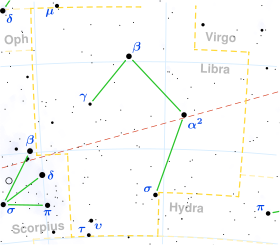Iota1 Librae
Iota1 Librae, Latinized from ι1 Librae, is a quadruple[3] star system in the constellation Libra. Its apparent magnitude is 4.54. It is located 379 light years from earth.[6]
 | |
| Observation data Epoch J2000.0 Equinox J2000.0 (ICRS) | |
|---|---|
| Constellation | Libra |
| Right ascension | 15h 12m 13.29025s[1] |
| Declination | −19° 47′ 30.1592″[1] |
| Apparent magnitude (V) | +4.54[2] |
| Characteristics | |
| Evolutionary stage | Blue subgiant |
| Spectral type | B9IVpSi + B9[3] |
| U−B color index | −0.38[2] |
| B−V color index | −0.08[2] |
| Variable type | Alpha2 Canum Venaticorum |
| Astrometry | |
| Radial velocity (Rv) | −11.6[2] km/s |
| Proper motion (μ) | RA: −35.40[1] mas/yr Dec.: −32.79[1] mas/yr |
| Parallax (π) | 8.59 ± 0.25[1] mas |
| Distance | 380 ± 10 ly (116 ± 3 pc) |
| Absolute magnitude (MV) | −0.79[4] |
| Orbit[5] | |
| Period (P) | 8163.16 d |
| Eccentricity (e) | 0.35 |
| Periastron epoch (T) | 2433155 JD |
| Argument of periastron (ω) (secondary) | 7.6° |
| Semi-amplitude (K1) (primary) | 3.4 km/s |
| Details | |
| Luminosity | 277[4] L☉ |
| Other designations | |
| Database references | |
| SIMBAD | data |
Visibility
Due to its southern location, although the star can be seen from most regions of the earth, observers in the southern hemisphere are more advantaged. Near Antarctica, it appears circumpolar, while it always remains invisible only in the vicinity of the Arctic Circle. Its magnitude of 4.5 means that naked-eye visibility is dependent on a sky sufficiently free from the effects of light pollution.
The best time for observation in the evening sky falls in the months between May and September; from both hemispheres of the period of visibility remains approximately the same, thanks to the position of the star not far from the celestial equator.
Physical
Iota1 Librae is a four star system.[3] The inner pair, designated components Aa and Ab, form a spectroscopic binary with an orbital period of 22.35 years and an eccentricity of 0.35.[5] The brighter member has a stellar classification of B9 IVp Si,[3] indicating it is a B-type subgiant star with an overabundance of silicon in the photosphere. It is a variable star of the Alpha2 Canum Venaticorum type with a magnitude that varies from 4.53 to 4.56, while its spectrum likewise shows variability.[7] The secondary component is of class B9.[3] The two stars are very close together (0.2 arcsec away), respectively of magnitude 5.1 and 5.5.[8][9]
A third component is located 57 arcsec distant; it is a star of the tenth magnitude, Iota1 Librae B.[6] The third component is also a double star, of equal magnitudes, 1.9 arcseconds apart.[10]
Due to its position on the ecliptic, it is sometimes obscured by the Moon or planets. A lunar occultation took place April 4, 2012.[11]
References
- van Leeuwen, F. (November 2007), "Validation of the new Hipparcos reduction", Astronomy and Astrophysics, 474 (2): 653–664, arXiv:0708.1752, Bibcode:2007A&A...474..653V, doi:10.1051/0004-6361:20078357.
- "iot01 Lib". SIMBAD. Centre de données astronomiques de Strasbourg. Retrieved 2017-12-16.
- Eggleton, P. P.; Tokovinin, A. A. (September 2008), "A catalogue of multiplicity among bright stellar systems", Monthly Notices of the Royal Astronomical Society, 389 (2): 869–879, arXiv:0806.2878, Bibcode:2008MNRAS.389..869E, doi:10.1111/j.1365-2966.2008.13596.x.
- Anderson, E.; Francis, Ch. (2012), "XHIP: An extended hipparcos compilation", Astronomy Letters, 38 (5): 331, arXiv:1108.4971, Bibcode:2012AstL...38..331A, doi:10.1134/S1063773712050015.
- Pourbaix, D.; et al. (2004), "SB9: The Ninth Catalogue of Spectroscopic Binary Orbits", Astronomy & Astrophysics, 424: 727–732, arXiv:astro-ph/0406573, Bibcode:2004A&A...424..727P, doi:10.1051/0004-6361:20041213.
- Extended Hipparcos Compilation (XHIP) (+ Anderson, 2012)
- General Catalogue of Variable Stars (Samus + 2007-2012)
- The Washington Visual Double Star Catalog (Mason + 2001-2012).
- Alcyone
- Burnam's Celestial Handbook, pp. 1107-1108.
- "Moon occults ι Librae (2012-04-09 02:03 CEST)". Turin Astronomical Observatory. Archived from the original on April 13, 2013. Retrieved March 23, 2012.